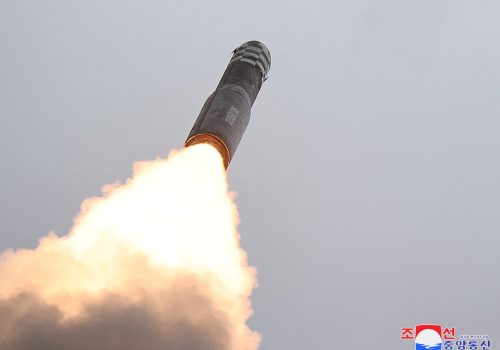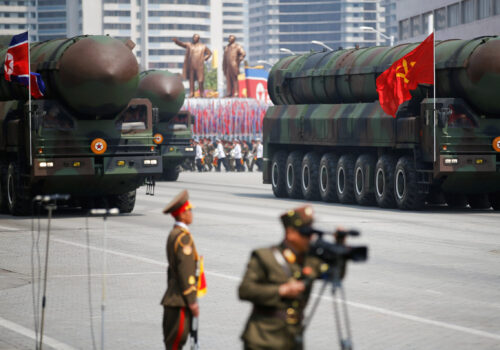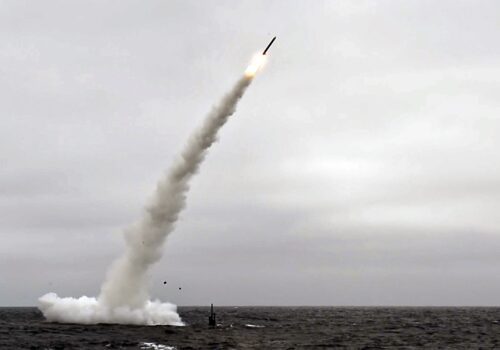Is the United States falling behind the North Korean ICBM threat? Congress needs answers.
Is the United States doing everything it reasonably can to protect the homeland against North Korean intercontinental ballistic missiles (ICBMs)? This is a question that should be on the mind of every member of Congress. “Defending the homeland” and “deterring strategic attacks against the United States” literally are the first two stated priorities in the 2022 National Defense Strategy, yet the United States devotes less than 1 percent of the defense budget toward stopping the strategic threat posed by an incoming ICBM. If left unaddressed, the North Korean ICBM threat may soon outpace US homeland defenses—begging the question: How can the United States leave itself vulnerable to a destitute country with less than 1 percent of the economic power of the United States?
North Korea’s ICBM program, decades in the making, has been showing dramatic progress in recent years. After launching satellites on ICBM-class rockets periodically since the 1990s and developing new missiles of regional range, it began testing mobile ICBMs with three launches in 2017. In 2020, it unveiled a much larger mobile ICBM, clearly large enough to carry multiple re-entry vehicles and decoys, which it began flight-testing in 2022. More ICBM launches followed in 2023, including a new solid-propellant ICBM, most recently this past February.
This move to solid-rocket motors reduces the launch time for its mobile ICBMs, improving prelaunch survivability against US counterstrikes. Given the sensitivities regarding intelligence on North Korea, there is no unclassified government estimate of the number of North Korean ICBMs. However, General Gregory Guillot, head of US Northern Command, said on March 12 that he is “concerned that Kim Jong Un’s growing ICBM stockpile could approach our capacity to defend North America.” Guillot added that this is “a challenge that will only expand in the coming years if Kim Jong Un looks to add multiple reentry vehicles to his missiles.”
Policymakers have to decide now whether the United States is doing enough to protect the homeland in the years ahead.
To counter this threat, the United States fields forty-four ground-based interceptors, each armed with a single nonexplosive “kill vehicle” (destroying its target on impact). These interceptors are based in Alaska and California, and they are supported by early warning satellites and ground- and sea-based radars. An additional twenty next-generation interceptors (NGIs) will begin deployment in 2028, each armed with multiple kill vehicles.
Will sixty-four interceptors by 2030 be enough to handle the North Korean ICBM threat? It is a tough call, since analysts cannot be sure how many ICBMs North Korea is planning to build and if the ICBMs will be armed with multiple warheads and countermeasures. It is also impossible to predict how many ICBMs and launchers the United States and its allies would be able to destroy prior to launch, given how difficult it is to track and destroy mobile solid-propellant ICBMs that can be hidden in tunnels. However, because of the rapid progress North Korea’s ICBM program has made in recent years, it is reasonable to assume that North Korea might have the capability to overwhelm the currently planned level of defense after several more years of ICBM development and production. Policymakers have to decide now whether the United States is doing enough to protect the homeland in the years ahead, because it will take years to increase the capability and capacity of US defenses. The United States must not wait until North Korea is regularly test-launching ICBMs with multiple re-entry vehicles and countermeasures to begin further improvements—it will be too late.
Why would a North Korean leader attack the United States with a nuclear weapon when the US military could devastate his country in return? This is a fair question, but can US leaders count on the forbearance and caution of Kim or his successor if, for example, the regime is facing imminent defeat in a conflict?
Defense planners cannot know for sure under what circumstances North Korea would use nuclear weapons either in the region or against the United States. However, North Korea’s official nuclear policy, made public by Pyongyang in 2022, provides a range of justifications for the first use of nuclear weapons during, or even before, a war. It explicitly declares that, in the event North Korea’s nuclear command and control is in “danger” due to an attack, nuclear forces will execute a pre-approved plan to strike “automatically and immediately” against the “command” of the attack. Taken at face value, this means North Korea’s ICBM force commanders may already be authorized, if North Korean command-and-control sites are struck by US or South Korean forces, to attack the Pentagon and the White House without an explicit order from Kim Jong Un. This further clarifies a long-standing threat of nuclear retaliation against the US homeland if the North Korean leadership is threatened. In 2017, the North Korean foreign ministry threatened a nuclear strike on the United States if Washington ever showed the “slightest sign of attempt to remove our supreme leadership.”
In other words, the United States or South Korea could inadvertently prompt a nuclear response against the US homeland even while mounting a conventional defense against North Korean aggression. Protection of the homeland against North Korean ICBMs lessens this risk, providing the US president more options and greater freedom of maneuver to bring the conflict to a successful close. Such defenses also would serve to reassure South Korea and Japan of the credibility of US extended deterrence guarantees by assuaging fears that North Korean ICBM threats would cause the United States to hesitate to come to their aid in the event of a North Korean attack.
Congress would be wise to pursue three lines of inquiry related to US homeland missile defense:
- Will the NGIs deploy on time and in the numbers necessary to pace the threat?
- Can the United States augment homeland protection in the near term with existing sea-based missile defenses?
- What can be done to accelerate space-based sensor support for homeland missile defense?
To begin, why is the Missile Defense Agency (MDA) requesting $414 million less in fiscal year 2025 for NGI than originally planned? Last year, MDA officials stated they were bringing two different NGI designs through critical design review, thereby fostering competition and reducing the technical risk that a particular design could fail. Why is the MDA now proposing to carry only one industry design? This might be penny wise and pound foolish.
Relatedly, Congress should determine whether the planned twenty NGIs are additive to the existing forty-four. If so, what is the plan to replace the older ground-based interceptors? The NGI, with its multiple kill vehicle design, is critical for staying ahead of the North Korean threat, so the entire fleet needs to be modernized. It is worth asking, too, where future NGIs should be deployed; a site on the east coast might help in the future against, for example, possible ICBM threats from Iran. Even better, why not make the NGI mobile and save on construction costs while improving its survivability? Decisions must be taken soon to prepare for an efficient production rate once the NGI is proven in testing.
Second, the Department of Defense can do more today to bolster homeland missile defense while waiting for the NGI. In a November 2020 test, the MDA and the US Navy intercepted a mock North Korean ICBM with the sea-based SM-3 block IIA missile. The MDA looked into using SM-3 IIA missiles—deployed on ships and/or on land—as an “underlayer” to its interceptors, but the concept was not pursued by the Biden administration. In a crisis or conflict with North Korea, ships armed with the SM-3 IIA missiles can be positioned to take a shot against an incoming North Korean ICBM. However, additional IIA missiles would need to be built and deployed. Congress should determine if additional funding can expedite production and whether the US Navy and US Northern Command have planned and exercised for this contingency capability.
Finally, key to staying ahead of North Korean ICBMs is the ability to distinguish between the real warhead and any accompanying countermeasures or decoys. While US forces do that today with ground-based radars, tracking (and discriminating) warheads is best done from space. The MDA’s new “Discriminating Space Sensor” is in the early stages of research, but it could “provide a pivotal capability as part of MDA’s space architecture,” as Vice Admiral Jon A. Hill, the then director of the the MDA, explained in May 2023. Congress should make this an item of special interest, with commensurate funding.
Needless to say, all this costs money. The fiscal year 2025 MDA budget request is $10.4 billion, of which $1.7 billion is for NGIs with an additional $1 billion to maintain and sustain the ground-based midcourse defense system with its forty-four interceptors. About a third of the MDA’s budget is devoted to homeland missile defense, which amounts to less than half of 1 percent of the entire defense budget. Just imagine what could be accomplished with a full 1 percent! Defending the homeland may be the top-stated national defense priority, but the budget request suggests otherwise. This may be where Congress ends up, but it should be a deliberate choice based on the facts—and the place to start evaluating those facts is at congressional hearings in the days and weeks ahead.
Robert M. Soofer is a senior fellow in the Forward Defense program of the Atlantic Council’s Scowcroft Center for Strategy and Security, where he leads the Nuclear Strategy Project. He served as deputy assistant secretary of defense for nuclear and missile defense policy from 2017 to 2021.
Further reading
Wed, Aug 16, 2023
The United States and its allies must be ready to deter a two-front war and nuclear attacks in East Asia
Report By Markus Garlauskas
This report highlights two emerging and interrelated deterrence challenges in East Asia with grave risks to US national security: 1) Horizontal escalation of a conflict with China or North Korea into simultaneous conflict; 2) Vertical escalation to a limited nuclear attack by either or both adversaries to avoid conceding.
Wed, Jan 31, 2024
A US-South Korea alliance strategic memo on deterrence
Issue Brief By Markus Garlauskas, Lauren D. Gilbert
With North Korea’s rapidly advancing military technology, aggressive nuclear policy changes, and deepening ties with the PRC making deterrence on the Korean Peninsula increasingly more complex, this is how the US and South Korea can shore up cooperative deterrence and boost alliance resilience.
Wed, Apr 3, 2024
The US is building a nuclear sea-launched cruise missile. Congress must make sure it’s built right.
New Atlanticist By Robert Soofer
There are forces at play—bureaucratic, budgetary, and programmatic—that could stymie the SLCM-N if US lawmakers do not pay close attention.
Image: A TV at Seoul's Yongsan Railway Station shows North Korean leader Kim Jong-Un (L) and his daughter believed to be named Kim Ju Ae (2nd from L) inspecting the launch of a Hwasong-18 solid-fuel intercontinental ballistic missile (ICBM). North Korea confirmed it test-fired a Hwasong-18 solid-fuel intercontinental ballistic missile (ICBM) the previous day, with North Korean leader Kim Jong Un saying the launch showed what option he would take "when Washington makes a wrong decision." The ICBM flew 1,002.3 kilometers for 4,415 seconds at a maximum altitude of 6,518.2 km before "accurately" hitting the East Sea, the KCNA said. (Photo by KIM Jae-Hwan / SOPA Images/Sipa USA)


